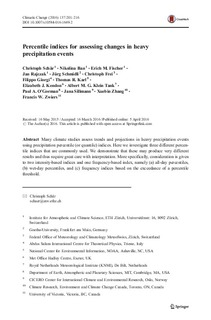| dc.contributor.author | Schaer, Christoph | |
| dc.contributor.author | Ban, Nikolina | |
| dc.contributor.author | Fischer, Erich M. | |
| dc.contributor.author | Rajczak, Jan | |
| dc.contributor.author | Schmidli, Juerg | |
| dc.contributor.author | Frei, Christoph | |
| dc.contributor.author | Giorgi, Filippo | |
| dc.contributor.author | Karl, Thomas R. | |
| dc.contributor.author | Kendon, Elisabeth J. | |
| dc.contributor.author | Klein Tank, Albert M. G. | |
| dc.contributor.author | O'Gorman, Paul A. | |
| dc.contributor.author | Sillmann, Jana | |
| dc.contributor.author | Zhang, Xuebin | |
| dc.contributor.author | Zwiers, Francis W. | |
| dc.date.accessioned | 2017-11-13T14:23:39Z | |
| dc.date.available | 2017-11-13T14:23:39Z | |
| dc.date.created | 2016-09-02T10:59:39Z | |
| dc.date.issued | 2016 | |
| dc.identifier.citation | Climatic Change. 2016, 137 (1), 201-216. | nb_NO |
| dc.identifier.issn | 0165-0009 | |
| dc.identifier.uri | http://hdl.handle.net/11250/2465973 | |
| dc.description.abstract | Many climate studies assess trends and projections in heavy precipitation events using precipitation percentile (or quantile) indices. Here we investigate three different percentile indices that are commonly used. We demonstrate that these may produce very different results and thus require great care with interpretation. More specifically, consideration is given to two intensity-based indices and one frequency-based index, namely (a) all-day percentiles, (b) wet-day percentiles, and (c) frequency indices based on the exceedance of a percentile threshold. Wet-day percentiles are conditionally computed for the subset of wet events (with precipitation exceeding some threshold, e.g. 1 mm/d for daily precipitation). We present evidence that this commonly used methodology can lead to artifacts and misleading results if significant changes in the wet-day frequency are not accounted for. Percentile threshold indices measure the frequency of exceedance with respect to a percentile-based threshold. We show that these indices yield an assessment of changes in heavy precipitation events that is qualitatively consistent with all-day percentiles, but there are substantial differences in quantitative terms. We discuss the reasons for these effects, present a theoretical assessment, and provide a series of examples using global and regional climate models to quantify the effects in typical applications. Application to climate model output shows that these considerations are relevant to a wide range of typical climate-change applications. In particular, wet-day percentiles generally yield different results, and in most instances should not be used for the impact-oriented assessment of changes in heavy precipitation events. | nb_NO |
| dc.language.iso | eng | nb_NO |
| dc.relation.uri | http://link.springer.com/article/10.1007/s10584-016-1669-2#enumeration | |
| dc.title | Percentile indices for assessing changes in heavy precipitation events | nb_NO |
| dc.type | Journal article | nb_NO |
| dc.type | Peer reviewed | nb_NO |
| dc.description.version | submittedVersion | nb_NO |
| dc.source.pagenumber | 201-216 | nb_NO |
| dc.source.volume | 137 | nb_NO |
| dc.source.journal | Climatic Change | nb_NO |
| dc.source.issue | 1 | nb_NO |
| dc.identifier.doi | 10.1007/s10584-016-1669-2 | |
| dc.identifier.cristin | 1377544 | |
| dc.relation.project | Norges forskningsråd: 229778/E10 | nb_NO |
| cristin.unitcode | 7475,0,0,0 | |
| cristin.unitname | CICERO Senter for klimaforskning | |
| cristin.ispublished | true | |
| cristin.fulltext | preprint | |
| cristin.qualitycode | 1 | |
